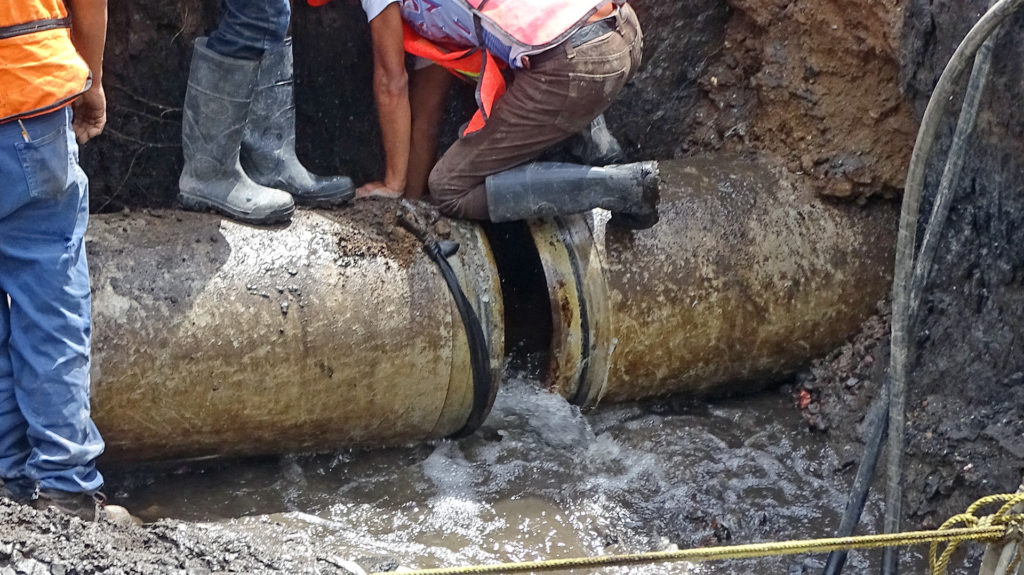Day 8 (Sunday, October 1, 2017).
As today was Sunday, we honestly weren’t sure what the day would have in store for us. “How much work will be happening on a Sunday? How many officials are going to be able to assist us? Will we get access to see anything interesting?” were some of the questions we were asking ourselves heading into the day. These questions will probably make a little more sense as the story goes on. Additionally, today was Team 2’s first day flying solo, as Team 1 had returned to the U.S. Until now, we have had the support of our Team 1 partners and the experience they gained in the days prior to our arrival. We all met up for coffee, breakfast, to plan out the day’s events, catch up on work from home, and say goodbye to our Team 1 teammates.
Team 2 came to Mexico City with a focus on observing lifeline systems, including emergency response facilities, healthcare, critical utility infrastructure, potable water distribution systems, wastewater distribution systems, and electrical systems. We had already observed several hospital facilities on previous days, but had yet to observe utility infrastructure damage. Yesterday, while observing building damage within the Centro Urbáno Benito Juarez area of Mexico City, we encountered a group from GEER (Geotechnical Extreme Events Response), who recommended we head down to Tláhuac in southeastern Mexico City, where there are ongoing water utility repairs. Therefore, that is where we decided to go today.

Upon arriving at Tláhuac, we immediately noticed the severe ground/soil movement that took place in several locations. There were numerous road closures where the soils had settled between 1 – 2 feet. The roads were simply not usable. There were a number of buildings with extensive structural damage, which is to be expected with the significant settlement. It didn’t take us long to find the ongoing utility repairs and, along the way, we ended up running into a second GEER team! Both GEER teams informed us that they are currently hypothesizing that an old river or canal may have run through the area and was previously filled-in so that homes could be built, but we didn’t have data to validate or prove this hypothesis.

Upon leaving the second GEER team, we received some aerial images of the area and had a better glimpse of the extent of the soil and utility damage. The pictures are pretty amazing! Some of the images show a straight line of soil settlement damage, which helped us make more sense of the GEER hypothesis. Additionally, we were able to see several of the openings where crews are currently in the process of repairing water lines.

After reviewing the aerials, the team pressed forward to observe the ongoing utility repairs. We were fortunate enough to talk to some of the on-site construction crew who informed us that the extent of the damage is currently unknown, with large segments of the local population in the area still without potable drinking water. At the time, the crew was digging up several joints along the road and finding that while some joints needed some type of repair, others needed significant attention.
Directly around the corner from the utility repairs we had observed is the Tláhuac hospital. We walked to the hospital entry with the hope of getting inside for some observations. As we walked up to the entry gate, we noticed it was closed. The police who were patrolling the hospital informed us that the hospital was fine, but it was closed for the day and we were informed that we would need to return during the week to request access through the director, which we may try to do.
Next, we decided to make an attempt to visit the water treatment plant in Iztapalapa. Again, we were greeted by security informing us that unfortunately they did not have the authority to give us access to the treatment plant; however, we were told that if we returned in the morning, they could connect us with the plant engineer, who could hopefully provide us with more information. As we returned to our hotel, I found myself reflecting on the things we saw today and wondering what plans we have in place back home to allow for rapid repairs to our lifeline systems.
Stay tuned for daily updates from our team… and if you have questions about our efforts, please comment below and we will respond with an answer.



Thank you, Team 1, Team 2, and Reid Middleton for being proactive and helping our neighbors in Mexico! I hope we can all learn as much as possible from this tragic event so we can be better prepared for a possible seismic activity in California.